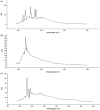Anti-inflammatory effects of the root, stem and leaf extracts of Chloranthus serratus on adjuvant-induced arthritis in rats
- PMID: 32503379
- PMCID: PMC8641675
- DOI: 10.1080/13880209.2020.1767159
Anti-inflammatory effects of the root, stem and leaf extracts of Chloranthus serratus on adjuvant-induced arthritis in rats
Abstract
Context: Chloranthus serratus [(Thunb.) Roem. et Schult, (Chloranthaceae)] is a folk medicine used for the treatment of rheumatoid arthritis.Objective: The aim of this study was to investigate anti-arthritic effects of the ethanol extracts of the roots (ER), stems (ES) and leaves (EL) of C. serratus on adjuvant arthritis rats and related mechanisms.Materials and methods: The rats were immunized by intradermal injection of complete Freund's adjuvant (CFA, 0.18 mL) into the right hind feet, and received intragastric administrations of the ER, ES and EL (2.07, 1.61 and 0.58 g/kg/d, respectively) for 14 days. The anti-arthritic activity was assessed by swelling rates, serum indicators, antioxidant capacity, histopathological and immunohistochemical analyses.Results: The LD50 of the ER, ES and EL was higher than 10.35, 8.05 and 2.90 g/kg/p.o., respectively. Extract treatments decreased swelling rates, tumour necrosis factor-alpha (TNF-α), vascular endothelial growth factor (VEGF), interleukin 1 beta (IL-1β), migration inhibitory factor 1 (MIF-1), immunoglobulin G (IgG) and immunoglobulin M (IgM) levels and positive expression of VEGF in the arthritic rats (p < 0.01 or p < 0.05). The ER significantly decreased NO (3.91 ± 0.61 µmol/L), IL-6 (75.67 ± 16.83 pg/mL) and malondialdehyde (MDA) (2.28 ± 0.32 nmol/mL) contents and clearly increased IFN-γ (2082 ± 220.93 pg/mL) and superoxide dismutase (SOD) (601.98 ± 38.40 U/mL) levels. The ES and EL did not reverse the changes in some indicators. All the extracts alleviated inflammatory cell infiltration and synovial cell proliferation. Among them, the ER was the most pronounced.Discussion and conclusions: ER exerts the most promising effects, as shown by inhibiting the releases of inflammatory cytokines and enhancing antioxidant capacity, which provides a scientific basis for further research on C. serratus and its clinical applications.
Keywords: Rheumatoid arthritis; arthritic score; articular cartilage; complete Freund’s adjuvant; oxidative stress; pro-inflammatory mediators.
Conflict of interest statement
No potential conflict of interest was reported by the author(s).
Figures







References
-
- Al-Herz A, Al-Awadhi A, Saleh K, Al-Kandari W, Hasan E, Ghanem A, Abutiban F, Alenizi A, Hussain M, Ali Y, et al. . 2017. Low prevalence of nodules in rheumatoid arthritis patients in Kuwait: a description and a comparison of patients from the Kuwait Registry for Rheumatic Diseases. Med Princ Pract. 26(2):152–156. - PMC - PubMed
-
- Chen J, Wu H, Wang Q, Chang Y, Liu K, Song S, Yuan P, Fu J, Sun W, Huang Q, et al. . 2014. Ginsenoside metabolite compound K alleviates adjuvant-induced arthritis by suppressing T cell activation. Inflammation. 37(5):1608–1615. - PubMed
-
- Costa NT, Iriyoda TMV, Kallaur AP, Delongui F, Alfieri DF, Lozovoy MA, Amin RB, Delfino VD, Dichi I, Simão AN.. 2016. Influence of insulin resistance and TNF-α on the inflammatory process, oxidative stress, and disease activity in patients with rheumatoid arthritis. Oxid Med Cell Longev. 2016:8962763. - PMC - PubMed
-
- Elberry AA, Abdel-Naim AB, Abdel-Sattar EA, Nagy AA, Mosli HA, Mohamadin AM, Ashour OM.. 2010. Cranberry (Vaccinium macrocarpon) protects against doxorubicin-induced cardiotoxicity in rats. Food Chem Toxicol. 48(5):1178–1184. - PubMed
MeSH terms
Substances
LinkOut - more resources
Full Text Sources
Research Materials
Miscellaneous
